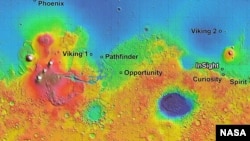The U.S. space agency, NASA, has narrowed down the potential landing sites for a 2016 mission to Mars to four locations.
Twenty-two sites were originally considered for the mission, which the scientists are calling the Interior Exploration Using Seismic Investigations, Geodesy and Heat Transport (InSight) lander. It is scheduled to launch in March of 2016 and land on Mars six months later.
Scientists will focus two of NASA's Mars Reconnaissance Orbiter cameras on the chosen four sites in the coming months to make a final decision between them. All four spots lie near each other on an equatorial plane in an area of Mars called Elysium Planitia.
NASA hopes the InSight lander will provide information on how Mars was formed, which also could provide a better understanding of how the rocky planets of the Solar System, including Earth, formed.
Unlike other missions, the main factor in determining the 2016 landing site is safety, meaning the sites should have a smooth terrain, few rocks and very little slope.
"This mission's science goals are not related to any specific location on Mars because we're studying the planet as a whole, down to its core," said Bruce Banerdt, InSight’s principal investigator at JPLin a statement. "Mission safety and survival are what drive our criteria for a landing site."
Each of the four sites is an ellipse measuring 130 kilometers from east to west and 27 kilometers from north to south. NASA says the InSight will have a 99 percent chance of landing within the chosen ellipse.
Elysium Planitia meets the requirements for InSight because it is close to the equator, so that the spacecraft’s solar array will be able to provide power all year. Also the areas are all low enough to allow the landing craft to decelerate more completely before landing.
The only other two areas of Mars meeting the requirements of being near the equator at low elevation, Isidis Planitia and Valles Marineris, were said to be too rocky and windy. Valles Marineris also lacks any swath of flat ground large enough for a safe landing.
Another requirement is that InSight needs to land on ground that allows the lander to deploy a heat-flow probe that will hammer itself several meters into the Martian surface to monitor heat coming from the planet’s interior.
In order to ensure there no hard rocks that might block the probe, scientists studied Mars Reconnaissance Orbiter images of large rocks near Martian craters formed by asteroid impacts. Impacts excavate rocks from the subsurface, so by looking in the area surrounding craters, the scientists can tell if the subsurface would have probe-blocking rocks lurking beneath the soil surface.
Twenty-two sites were originally considered for the mission, which the scientists are calling the Interior Exploration Using Seismic Investigations, Geodesy and Heat Transport (InSight) lander. It is scheduled to launch in March of 2016 and land on Mars six months later.
Scientists will focus two of NASA's Mars Reconnaissance Orbiter cameras on the chosen four sites in the coming months to make a final decision between them. All four spots lie near each other on an equatorial plane in an area of Mars called Elysium Planitia.
NASA hopes the InSight lander will provide information on how Mars was formed, which also could provide a better understanding of how the rocky planets of the Solar System, including Earth, formed.
Unlike other missions, the main factor in determining the 2016 landing site is safety, meaning the sites should have a smooth terrain, few rocks and very little slope.
"This mission's science goals are not related to any specific location on Mars because we're studying the planet as a whole, down to its core," said Bruce Banerdt, InSight’s principal investigator at JPLin a statement. "Mission safety and survival are what drive our criteria for a landing site."
Each of the four sites is an ellipse measuring 130 kilometers from east to west and 27 kilometers from north to south. NASA says the InSight will have a 99 percent chance of landing within the chosen ellipse.
Elysium Planitia meets the requirements for InSight because it is close to the equator, so that the spacecraft’s solar array will be able to provide power all year. Also the areas are all low enough to allow the landing craft to decelerate more completely before landing.
The only other two areas of Mars meeting the requirements of being near the equator at low elevation, Isidis Planitia and Valles Marineris, were said to be too rocky and windy. Valles Marineris also lacks any swath of flat ground large enough for a safe landing.
Another requirement is that InSight needs to land on ground that allows the lander to deploy a heat-flow probe that will hammer itself several meters into the Martian surface to monitor heat coming from the planet’s interior.
In order to ensure there no hard rocks that might block the probe, scientists studied Mars Reconnaissance Orbiter images of large rocks near Martian craters formed by asteroid impacts. Impacts excavate rocks from the subsurface, so by looking in the area surrounding craters, the scientists can tell if the subsurface would have probe-blocking rocks lurking beneath the soil surface.










